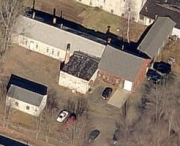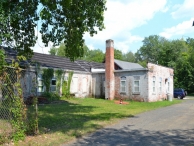Mill Record Southington
RETURN TO ‘FIND MILLS’Disclaimer: Content for these properties was compiled in 2014-2017 from a variety of sources and is subject to change. Updates are occasionally made under Property Information, however the Connecticut Trust for Historic Preservation (dba Preservation Connecticut) makes no representation or warranty that the information is complete or up-to-date.
- Complex Name (Common)
- Thomson Drop Forge Co.
- Complex Name (Historic)
-
- Thomson Drop Forge Co.
- Address or Location
- 379 Summer Street, Plantsville, Southington
- County
- Hartford
- Historic Designation
- Associated Mill Community
- n/a
- Historic Information
Companies Associated w/Complex
- Acme Manufacturing Co. ca. 1900-ca. 1903
- Beaton & Bradley Co. 1894-ca. 1900
- Connecticut Motor Co. 1889-1893
- Hurwood Co. 1901-ca. 1903
- Lauria Machine Co. ca. 1947-mid-late-20th c.
- Thomson Drop Forge Co. ca. 1903-ca. 1947
- Tiger Enterprises 1982-Present (2015)
Use (Historic)
Largest Documented Workforce
10-24 (1939).
Historic Narrative
The oldest portion of the former Thomson Drop Forge Company plant – as well as the blocks to the north formerly occupied by the Hurwood Company factory – was originally erected by the Connecticut Motor Company in 1889. This firm was organized by R.E. Dunston and Clarence Sterling in 1888 and initially operated in Hartford, Connecticut, yet relocated to the Plantsville section of Southington following aggressive courting by the town’s Board of Trade. The Connecticut Motor Company manufactured inexpensive electric motors used in a variety of applications ranging from manufacturing to streetcar systems. Despite initial successes and promise, the firm closed its doors in 1893. The Summer Street plant subsequently passed to the Beaton and Bradley Company, a steam fitting manufacturer in 1894, and then the Acme Manufacturing Company ca. 1900. In 1901, George E. Wood, a resident of Southington, contracted with John A. Hurley, proprietor of the Acme Manufacturing Company, to produce a solid-headed screwdriver of Wood’s own design. This work took place under the Hurwood Company from 1901 until around 1903 when Hurley relocated to Bridgeport, Connecticut. Wood then formed the G.E. Wood Tool Company and continued to manufacture screwdrivers in the northern of the two manufacturing buildings erected by Connecticut Motor Company. The southern building was occupied by the newly-formed Thomson Drop Forge Company around the same time. The Thomson Drop Forge Company was organized by four members of the Thomson family, natives of Orange, Connecticut, on June 10, 1903. The firm manufactured small tools and drop forgings and was led by George Thomson, president; John Thomson, vice-president; Albert Thomson, treasurer; and Thomas W. Thomson, secretary. The most notable of the proprietors may likely be Thomas W. Thomson, as he boasted 24 years of experience working with the Sterling Organ Company (later the Sterling Piano Company) of Derby, Connecticut, and is credited with manufacturing the first piano to be produced by that significant firm. In 1912, Thomas Thomson became sole proprietor of the Thomson Drop Forge Company. The Thomson Drop Forge Company continued to produce an array of drop forgings, hardware, and small tools through the 1920s and 1930s, and into the 1940s. The hand tools manufactured by the firm included double-end wrenches, ball peen machinists’ hammers, cold chisels, and screw drivers. Among the latter was a line of the company’s ‘Thomson Indestructible’ screwdrivers, which were guaranteed against breakage. Around 1920, in order to keep up with demand, the firm acquired the former Peck, Stow and Wilcox plant a short distance to the south at the intersection of Summer and West Main Streets. The Thomson Drop Forge Company continued to occupy the Summer Street plant until ca. 1947, when the business was consolidated on West Main Street. The vacated factory was subsequently acquired by the Lauria Machine Company, a machine tool manufactory established and operated by John Lauria and Michael Zibell.
- Architectural Information
Number of Existing Buildings
Three (3) adjoining primary blocks.
Dates of Construction
1889, ca. 1903.
Architect
n/a
Builder
n/a
Building Type
Architectural Description
The former Thomson Drop Forge Company plant is comprised of roughly three adjoining blocks located on the east side of Summer Street, roughly 230’ north of Summer Street’s intersection with Cowles Avenue. The oldest portion of the complex was built in 1889 and consists of a one-story, 32’ x 98’ red brick machine shop with segmental-arched window openings with stone sills, a denticulated brick cornice with cornice returns, and a front-facing gable roof with a circular window in its façade (west elevation) gable end. A one-story, 28’ x 32’ red brick engine room with a rectangular brick chimney on its west elevation adjoins the eastern end of the machine shop’s south (side) elevation. This appears to have been erected concurrent to the machine shop and is of similar detailing. The primary difference between the two blocks is that the engine room has a flat roof with a brick parapet on its southern elevation, however, this difference may be attributed to a number of fires that impacted the plant during the early-20th century. The plant was enlarged ca. 1903 through the addition of a one-and-a-half-story, 38’ x 42’ wood-frame forge building adjoining the eastern elevation of the machine shop. This has asphalt shingle siding, rectangular window openings with plain wood frames, and a front-facing gable roof. A one-story, 52’ x 20’ steel-frame ell erected ca. 1980 connects the ca. 1903 block to the former Hurwood Company plant to the north.
Exterior Material(s)
Structural System(s)
Roof Form
Roof Material
Power Source
Condition
Fair
Condition Notes
The complex is in fair condition. The brick blocks are in need of repairs and repointing and the original windows throughout the plant have been replaced or infilled.
- Property Information
-
Specific Location
Only the southernmost blocks of one legal parcel (379 Summer Street) totaling 2.58 acres located on the east side of Summer Street, roughly 230’ north of Summer Street’s intersection with Cowles Avenue.
Adjacent To
n/a
Exterior Visible from Public Road?
Yes
Parcel ID / Assessor Record Link
- 075023 southern blocks / Link →
Acreage
2.58
Use (Present)
- Sources
-
Form Completed By
Lucas A. Karmazinas
Date
08/17/2015
Bibliography
- List of Connecticut Manufacturers, 1922, 1924, 1930, 1932.
- Directory of Connecticut State Manufacturers, 1936, 1939.
- Industrial Directory of Connecticut, 1947.
- Register of War Production Facilities in Connecticut, 1951.
- Atlas of Hartford County, Beers, Baker & Tilden, 1869.
- Sanborn Map Company, 1890, 1895, 1901, 1911, 1923, 1947.
- Aerial Survey of Connecticut, 1934, 1965.
- The Hartford Courant, 1889, 1903, 1905.
- History of Hartford County, Connecticut; Burpee, Charles W., 1928.
- Representative View(s)Click on image to view full file






